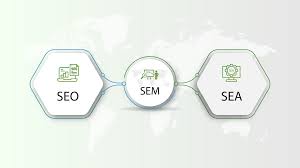The Difference Between SEO and SEA
Search Engine Optimization (SEO) and Search Engine Advertising (SEA) are two essential components of any successful digital marketing strategy. While both aim to increase a website’s visibility in search engine results, they achieve this goal through different methods.
SEO: Search Engine Optimization
SEO focuses on optimizing a website’s content, structure, and other elements to improve its organic (unpaid) search engine rankings. This involves using relevant keywords, creating high-quality content, improving website speed and user experience, and building backlinks from reputable sources. SEO is a long-term strategy that requires continuous effort to maintain and improve a website’s search engine rankings over time.
SEA: Search Engine Advertising
SEA, also known as pay-per-click (PPC) advertising, involves placing ads on search engine results pages to drive traffic to a website. Advertisers bid on keywords relevant to their target audience, and their ads are displayed when users search for those keywords. With SEA, advertisers pay each time a user clicks on their ad. This method provides immediate visibility for a website but requires ongoing investment to sustain traffic.
The Key Differences
- SEO is organic and focuses on improving unpaid search rankings, while SEA is paid advertising that guarantees immediate visibility.
- SEO requires continuous effort to maintain and improve rankings over time, while SEA provides instant results but requires ongoing investment.
- SEO is more cost-effective in the long run as it generates organic traffic without direct advertising costs, while SEA incurs costs for each click on an ad.
- SEO builds credibility and trust with users over time through high-quality content and optimized websites, while SEA relies on paid placements for visibility.
In conclusion, both SEO and SEA play crucial roles in driving traffic to websites and increasing online visibility. By understanding the differences between these two strategies and incorporating them effectively into your digital marketing efforts, you can maximize your website’s reach and achieve your business goals.
Understanding SEO and SEA: Key Differences, Definitions, and Their Synergy in Marketing
- What does SEA mean in marketing?
- How do SEO and SEA work together?
- What is SEO and SCO?
- What is the difference between SEO and SEA vs SEM?
- What is the difference between SEO and SEA?
- What is SEO and SEA abbreviation?
- What is SEA in SEO?
- How can SEO and SEA work together?
What does SEA mean in marketing?
In marketing, SEA stands for Search Engine Advertising. SEA is a digital marketing strategy that involves placing ads on search engine results pages to increase a website’s visibility and drive traffic. Advertisers bid on specific keywords related to their target audience, and their ads are displayed when users search for those keywords. With SEA, advertisers pay each time a user clicks on their ad, making it a cost-effective way to reach potential customers and generate immediate visibility for a website.
How do SEO and SEA work together?
When it comes to digital marketing strategies, SEO and SEA can work together synergistically to maximize a website’s visibility and reach. SEO focuses on improving organic search rankings through optimizing content and website elements, while SEA involves paid advertising to drive immediate traffic. By integrating SEO keywords and insights into SEA campaigns, businesses can target specific audiences effectively and enhance their overall online presence. Additionally, data from SEA campaigns can provide valuable insights for refining SEO strategies, creating a cohesive approach that boosts both organic and paid search performance. Ultimately, by aligning SEO and SEA efforts, businesses can create a comprehensive digital marketing strategy that delivers optimal results in driving traffic and increasing conversions.
What is SEO and SCO?
Search Engine Optimization (SEO) and Search Engine Advertising (SEA) are commonly confused with other terms, such as SCO. SEO refers to the practice of optimizing a website to improve its organic search engine rankings, while SEA involves paid advertising to increase a website’s visibility in search engine results. On the other hand, SCO is not a standard industry term and may refer to a typo or misunderstanding of SEO. Understanding the distinctions between these terms is crucial for implementing an effective digital marketing strategy that drives traffic and enhances online presence.
What is the difference between SEO and SEA vs SEM?
When it comes to digital marketing strategies, understanding the distinctions between SEO, SEA, and SEM is crucial. SEO (Search Engine Optimization) and SEA (Search Engine Advertising) are subsets of SEM (Search Engine Marketing). SEO focuses on optimizing a website’s organic search rankings through content and technical enhancements, while SEA involves paid advertising to increase visibility on search engine results pages. On the other hand, SEM encompasses both SEO and SEA strategies to improve a website’s overall search engine performance. By leveraging the unique strengths of each component, businesses can create a comprehensive digital marketing approach that drives traffic and enhances online presence effectively.
What is the difference between SEO and SEA?
One commonly asked question in the realm of digital marketing is, “What is the difference between SEO and SEA?” Search Engine Optimization (SEO) involves optimizing a website’s content and structure to improve its organic search engine rankings, focusing on unpaid methods to increase visibility. On the other hand, Search Engine Advertising (SEA) utilizes paid advertising strategies, such as pay-per-click (PPC) campaigns, to display ads on search engine results pages and drive immediate traffic to a website. While SEO is a long-term strategy that requires continuous effort for sustainable results, SEA provides instant visibility but necessitates ongoing investment to maintain traffic levels. Understanding the distinctions between SEO and SEA is essential for businesses looking to enhance their online presence effectively.
What is SEO and SEA abbreviation?
SEO and SEA are common abbreviations in the digital marketing world. SEO stands for Search Engine Optimization, which refers to the practice of optimizing a website to improve its organic search engine rankings. On the other hand, SEA stands for Search Engine Advertising, also known as pay-per-click advertising, where advertisers bid on keywords to display ads on search engine results pages. Understanding the differences between SEO and SEA abbreviations is crucial for developing a comprehensive online marketing strategy that effectively boosts a website’s visibility and drives traffic.
What is SEA in SEO?
“SEA in SEO refers to Search Engine Advertising, which is a paid marketing strategy that involves placing ads on search engine results pages to increase a website’s visibility. While SEO (Search Engine Optimization) focuses on optimizing a website’s organic search rankings through various techniques like keyword optimization and content creation, SEA complements SEO efforts by providing immediate visibility through paid advertisements. By incorporating both SEO and SEA strategies effectively, businesses can enhance their online presence and attract targeted traffic to their websites.”
How can SEO and SEA work together?
When it comes to digital marketing strategies, integrating SEO and SEA can be highly beneficial for maximizing online visibility and driving targeted traffic to a website. By combining the strengths of both approaches, businesses can create a comprehensive marketing strategy that leverages the long-term benefits of SEO with the immediate results of SEA. SEO can help establish a strong organic presence in search engine results, while SEA can provide additional visibility through paid advertising. Coordinating keyword research, content optimization, and ad targeting efforts between SEO and SEA campaigns can enhance overall performance and deliver more effective results in reaching and engaging the target audience. This synergy between SEO and SEA allows businesses to achieve a holistic approach to online marketing that boosts brand awareness, increases website traffic, and ultimately drives conversions.




